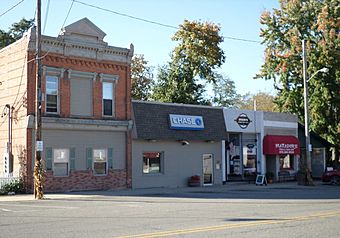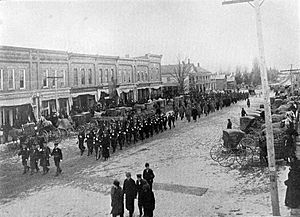Byron Historic Commercial District facts for kids
Quick facts for kids |
|
|
Byron Historic Commercial District
|
|
 |
|
| Location | Roughly Saginaw St. from Maple to Water Sts., Byron, Michigan |
|---|---|
| Area | 12 acres (4.9 ha) |
| Architectural style | Late 19th And 20th Century Revivals, Late Victorian, Greek Revival |
| NRHP reference No. | 84001848 |
| Added to NRHP | September 13, 1984 |
The Byron Historic Commercial District is a special area in downtown Byron, Michigan. It includes many old shops and buildings along Saginaw Street, from Maple Street to Water Street. This district was added to the National Register of Historic Places in 1984 because of its important history and unique buildings.
History of Byron's Downtown
In 1824, a man named Samuel W. Dexter started the village of Byron. He was known for buying and selling land, and he also founded Dexter, Michigan.
Byron began to grow quickly. In 1836, Dexter sold his part of the village to a group called the "Byron Mill Company." Their goal was to make Byron a center for cutting timber. They built a dam on the river and set up a sawmill.
The first wooden house in the village was built in 1837. A few years later, in 1841 and 1842, Byron got its first hotel and general store in what is now the downtown area. Also in 1842, the mill changed owners. The new owners rebuilt it as a flour mill, which showed that farming was becoming very important in the area.
Over the next few decades, growing wheat and raising sheep became big parts of the local economy. The village of Byron slowly grew to serve the farmers nearby. Even though Byron never became a huge trading center, it did see more business. People even started making farming tools there.
Growth and Changes
Byron grew even faster in the 1880s and 1890s as people needed more goods. However, the village stayed fairly small because railroads didn't come through Byron. Still, most of the buildings you see in the downtown area today were built in the 1880s.
In the 1900s, cars became popular, and farms around Byron became bigger businesses. This changed how the shops in the commercial district were used. In the 1910s, a grain elevator was built, and the old mill was rebuilt as a feed mill.
Today, the downtown area still has many historic buildings from the 1800s. However, a big fire in 2012 damaged many buildings in one block of the district.
What Makes the District Special?
The Byron Historic Commercial District covers about two and a half blocks in the village's downtown. It includes 35 buildings. Most of these are one- or two-story commercial buildings, like shops. There are also nine houses, a mill, a factory, a dam, and a bridge.
Out of these 35 buildings, 26 are considered "contributing" buildings. This means they help show the historic character of the district. These buildings were built between 1840 and 1940. They show different architectural styles, including Greek Revival, Italianate, and early 20th-century designs. They are made of wood and brick.
Some of the very first buildings in Byron are part of this district. This includes the first wooden house in the village, built in 1837. You can also find the village's first store, built around c. 1840, and an inn from 1848, which replaced an earlier inn built in 1842.


